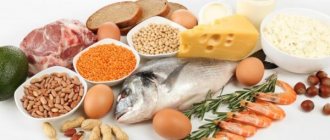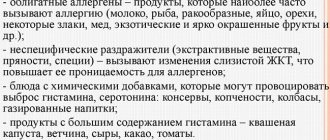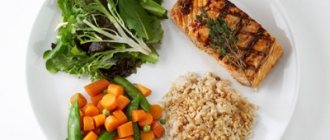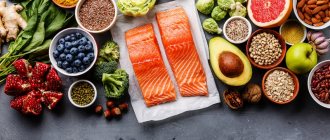Arthrosis is a chronic disease in which progressive degenerative changes occur in the cartilage tissue of the joints. Along with drug therapy and physiotherapy, a complete, balanced diet is important, aimed at providing the body with the necessary nutrients, improving metabolism and slowing down the process of deformation of the joint structure.
If you have
arthrosis of the joints
, then you should regularly
carry out preventive treatment
.
General rules. Duration of the diet.
Nutritional correction for arthrosis has a positive effect on treatment results and improves the patient’s quality of life.
The therapeutic diet for arthrosis imposes certain rules:
- A varied diet. Nutrition should be complete and balanced.
- Limit salt intake to 5-8 grams per day. Smoked meats, canned food and other salty foods are removed from the diet)
- Drinking regime. It is recommended to increase the consumption of non-carbonated mineral water to 2-2.5 liters per day.
- Introduction to the menu of foods rich in vegetable oils, especially unsaturated fatty acids omega-3 and omega-6.
- It is useful to prepare jellies, jellied fish, fruit jellies and jelly. The mucopolysaccharides they contain help normalize the structure of cartilage tissue and stimulate its synthesis.
Reviews and results
Reviews from the overwhelming number of patients suffering from diseases of certain joints indicate that proper nutrition for arthrosis and arthritis plays an important role in the process of treatment and rehabilitation, especially in the initial stage of the disease in the absence of persistent morphological changes in the structure of the joints.
- “... Almost 10 years ago I was diagnosed with stage 2 deforming arthrosis of the knee joints. I tried many different treatment methods: pills, exercise therapy and sanatorium-resort treatment. Frankly speaking, the effect is negligible. The process either subsides or worsens again, especially after physical activity, a cold or drinking alcohol. I tried to eat according to Breg and was on a vegetarian diet; on the advice of friends, I wanted to try fasting, but the doctor did not recommend it to me. I try to adhere to the doctor’s recommendations on proper nutrition and adequate stress on the joints. Now I give injections inside the joint, it helps more or less. I don’t even know what will happen next, I’m only 45 years old and I’m afraid of becoming disabled”;
- “... After a minor shoulder injury, 2-3 months later, osteoarthritis of the right shoulder joint developed with severe pain and limitation of movement. In addition, the examination revealed advanced osteochondrosis of the cervical spine. He was treated in a specialized clinic for almost 6 months with two breaks. They did massage of the shoulder and collar area, manual therapy, various physical procedures, underwent 7 shock wave therapy procedures, injected NSAIDs, and B vitamins. At home, I did special exercises, followed nutritional recommendations, and took chondroitin sulfate. Progress was insignificant until several intra-articular injections of hormonal glucocorticosteroid drugs were given. After this, recovery began and after 2 months, movements were almost completely restored, and the pain went away.”
What can you do for arthrosis of the joints? List of permitted products.
SOUPS:
Soups made from weak meat and fish broths with the addition of cereals and vegetables.
MEAT:
Low-fat meats Idea, chicken, veal, rabbit.
Jellies and meat aspic. FISH:
River and sea.
Red varieties are preferred. Jellies and fish aspic. DAIRY PRODUCTS:
Low-fat fermented milk and fermented milk products - kefir, fermented baked milk, yogurt, as well as lean cheese, dietary cottage cheese and yogurt.
BREAD:
Wholemeal and wholemeal breads.
VEGETABLES:
Almost any vegetables are allowed, both raw and thermally processed.
It is necessary to minimize the consumption of tomatoes. It is recommended to add flax and sesame seeds to salads. FRUIT:
Almost all types of fruit are allowed, but in small quantities.
Jelly made from natural fruits and berries is recommended. DRINKS:
Compotes, decoctions, green tea with lemon, fruit juice, alkaline mineral water.
Symptoms
Symptoms of arthrosis practically do not depend on its cause and location, since changes in the joints follow the same scenario. The disease develops gradually and begins to manifest itself when the cartilage is quite seriously damaged.
One of the first signs of trouble is a crunching sound in the problem area when moving. It most often occurs when the knee or shoulder is affected. At the same time, a person may feel a slight decrease in mobility after prolonged inactivity, for example, in the morning.
When asked what symptoms appear with arthrosis, most patients name pain first. At first insignificant and weak, it gradually gains strength, preventing normal movement. Depending on the stage and location of the pathology, a person may feel:
- starting pain: occurs during the first movements after prolonged inactivity of the joint and is associated with the formation of a thin film of destroyed tissue on the surface of the cartilage; after starting work, the film moves and the discomfort disappears;
- pain during prolonged physical activity (standing, walking, running, etc.): appears due to a decrease in the shock-absorbing properties of the joint;
- weather pain: provoked by low temperature, humidity, changes in atmospheric pressure;
- night pain: associated with venous stagnation and increased blood pressure inside the bones;
- joint blockade: sharp, severe pain associated with pinching of a piece of cartilage or bone located in the joint cavity.
As arthrosis develops, the symptoms become more noticeable, the patient notes the following signs:
- increase in morning stiffness;
- intensification and increase in duration of pain;
- decreased mobility;
- joint deformation due to bone growths;
- deformation of bones and surrounding tissues: the process is clearly visible on the limbs and fingers, which become noticeably curved.
When inflammation occurs, the affected area swells, turns red and becomes hot to the touch. Pressing on it causes a sharp increase in pain.
What is not allowed for arthrosis of the joints? List of completely or partially restricted products.
SOUPS:
Soups with concentrated meat and fish broths are prohibited.
MEAT:
Fatty varieties of red meat, semi-finished products, smoked meats, and sausages are undesirable.
It is recommended to minimize the consumption of offal (liver, kidneys, heart). FISH:
River and sea.
Fried, smoked or pickled fish is prohibited. DAIRY PRODUCTS:
Sour cream, cream, full-fat cheese.
BREAD:
Bread, yeast baked goods, and high-calorie cream confectionery products are not allowed.
VEGETABLES:
Canned vegetables should not be consumed.
DRINKS:
Alcohol, strong tea and coffee are prohibited.
SPICES, CONDITIONINGS:
Hot spices and seasonings are not allowed.
Reasons for development
The main factor in the development of arthrosis is the discrepancy between the load experienced and the ability of the joint to withstand this load. Acute or chronic, this process inevitably leads to tissue destruction.
The list of reasons that increase the risk of developing arthrosis of any localization includes:
- heredity;
- endocrine pathology (diabetes mellitus);
- injuries of the articular apparatus: bruises, dislocations, fractures or cracks of bones inside the joint capsule, complete or partial ruptures of ligaments, penetrating wounds;
- regular increased load on the joints associated with the profession);
- obesity;
- hypothermia;
- previous inflammatory diseases of the joints: acute arthritis, tuberculosis, etc.;
- blood diseases in which bleeding into the joint often occurs (hemophilia);
- sudden changes in hormonal levels (pregnancy, menopause);
- local circulatory disorders due to atherosclerosis, varicose veins, thrombophlebitis, etc.;
- autoimmune diseases (rheumatoid arthritis, systemic lupus erythematosus, etc.);
- connective tissue dysplasia (congenital pathology, accompanied, among other things, by excessive joint mobility);
- congenital pathologies of the musculoskeletal system (flat feet, dysplasia or congenital dislocation of the hip joint, etc.);
- age over 45-50 years (increased risks are associated with a decrease in collagen synthesis);
- osteoporosis (bone loss);
- chronic intoxication of the body (including salts of heavy metals, drugs, alcohol);
- surgical interventions on joints.
Recipes for dietary dishes for arthrosis
(Diet features for adults/children)
Arthrosis of the joints in children is very rare; the disease is more typical in adults aged forty-five years and older. Treatment must be carried out under the supervision of a doctor. Diet recommendations include providing the child with a complete, balanced diet without reducing its nutritional value. In this case, it is necessary to completely exclude such products as smoked meats, sausages and confectionery products (especially cream-containing ones), chips, sweet carbonated drinks, and too fatty dishes.
Arthrosis at a young age
To date, the reasons for the development of arthrosis in young people have not yet been fully studied. Scientists put forward the opinion that the disease is the result of a gene mutation , during which collagen . This substance is the main component of all cartilage. As a result of a lack of collagen fibers, the articular surfaces are gradually erased . In this case, the diet is aimed at slowing down the destruction of cartilage.
Do not forget that arthrosis cannot appear overnight, it is a slow, long-term process, which is a consequence of degenerative-dystrophic changes in the joints, often provoked in the younger generation by the following factors :
- Heavy loads/ injuries /joint surgeries
- Sedentary lifestyle
- Unbalanced diet
- Physical overload (mainly people of professional training level suffer)
- Disturbances in the hormonal system/ immune
- Excess weight
- Flat feet
- Hypothermia of the joints
Arthrosis in young people
Just like stroke/heart attack, which is a consequence of “bad blood vessels” caused by a long-term increase in the level of “bad” low-density cholesterol, arthrosis is a slow killer of your joints.
Nutritionist comments:
Compliance with the doctor’s nutritional instructions leads to a reduction in the load on the limbs and spine, improves the quality of cartilage tissue, and slows down (and even stops) further destruction of the joint.
“The right choice of a sanatorium is a significant step towards maintaining and increasing health. “Gorny” is a resort complex that combines the experience and knowledge of Russian and Soviet balneology. The presence of modern medical equipment and innovative installations, the professionalism of the staff and love for their work will serve as the key to extending longevity,” - head doctor of the sanatorium Alexander Olegovich Karaulov.
Arthrosis as a result of professional activity
The risk group includes people who experience stress on their joints during their professional activities . For example, a seamstress must reproduce the same manipulations that require effort. As a result, arthrosis of the small joints on the fingers develops.
Arthrosis affects workers not only who experience obvious harmful effects on the joints in the form of shocks and jolts , but also people who constantly keep their joints under static tension.
The most common professions that are affected by arthrosis:
- Miners
- Masons
- Hammermen
- Miners
Over time, workers in such professions experience pain in the joints, first briefly , coming and going, then with the progression of arthrosis, the pain intensifies and becomes constant.
Arthrosis in workers
In the most advanced cases, employees are diagnosed with professional disability , are offered either to retrain and choose another job (according to Part 1 of Article 73 of the Labor Code of the Russian Federation ) that is less harmful, which has no contraindications for the health problems identified in them, or are generally fired under the article (according to paragraph 5 of Article 83 of the Labor Code of the Russian Federation).
Causes of deforming arthrosis of the elbow joint
When studying the causes of arthrosis of the elbow joint, it should first of all be noted that the development of pathology, as a rule, is accompanied by factors of both external and internal influence.
Among the main causes of arthrosis of the elbow joint it is worth noting:
- changes associated with natural changes in the human body;
- inappropriate lifestyle of a person;
- harsh conditions of professional activity;
- consequences of previous injuries;
- disruption of the body's metabolic processes;
- prolonged inflammatory processes;
- intoxication;
- hormonal disbalance;
- past infectious diseases.
Diagnostics
The primary diagnosis of arthrosis is made during examination. In the future, a complex of physical and chemical methods is used to identify the extent of the disease, developmental features, causes, as well as research for problems with similar symptoms.
- Laboratory blood test (determination of rheumatoid factor, trace element content, exclusion of arthritis, etc.).
- X-ray to identify the stage of arthrosis.
- MRI and CT (depending on the cause and severity of the disease for a more accurate diagnosis).
- Ultrasound (to determine the thickness of the cartilage, the lumen of the joint capsule).
- Densitometry for the diagnosis of osteoporosis.










